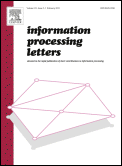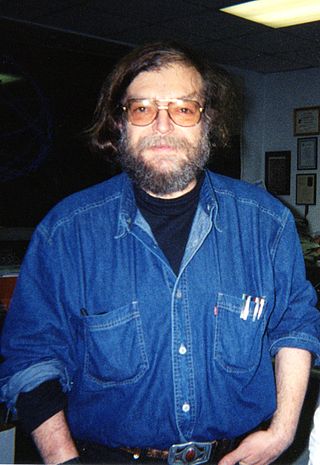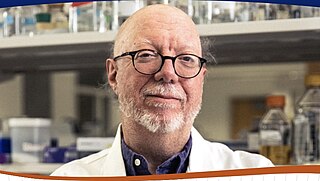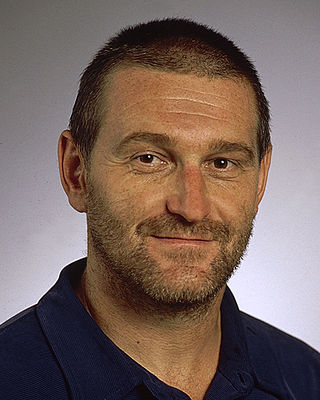Related Research Articles

Ronald Linn Rivest is a cryptographer and computer scientist whose work has spanned the fields of algorithms and combinatorics, cryptography, machine learning, and election integrity. He is an Institute Professor at the Massachusetts Institute of Technology (MIT), and a member of MIT's Department of Electrical Engineering and Computer Science and its Computer Science and Artificial Intelligence Laboratory.

DNA computing is an emerging branch of unconventional computing which uses DNA, biochemistry, and molecular biology hardware, instead of the traditional electronic computing. Research and development in this area concerns theory, experiments, and applications of DNA computing. Although the field originally started with the demonstration of a computing application by Len Adleman in 1994, it has now been expanded to several other avenues such as the development of storage technologies, nanoscale imaging modalities, synthetic controllers and reaction networks, etc.
Theoretical computer science (TCS) is a subset of general computer science and mathematics that focuses on mathematical aspects of computer science such as the theory of computation (TOC), formal language theory, the lambda calculus and type theory.

DNA origami is the nanoscale folding of DNA to create arbitrary two- and three-dimensional shapes at the nanoscale. The specificity of the interactions between complementary base pairs make DNA a useful construction material, through design of its base sequences. DNA is a well-understood material that is suitable for creating scaffolds that hold other molecules in place or to create structures all on its own.

Randal E. Bryant is an American computer scientist and academic noted for his research on formally verifying digital hardware and software. Bryant has been a faculty member at Carnegie Mellon University since 1984. He served as the Dean of the School of Computer Science (SCS) at Carnegie Mellon from 2004 to 2014. Dr. Bryant retired and became a Founders University Professor Emeritus on June 30, 2020.

Kurt Mehlhorn is a German theoretical computer scientist. He has been a vice president of the Max Planck Society and is director of the Max Planck Institute for Computer Science.

Information Processing Letters is a peer-reviewed scientific journal in the field of computer science, published by Elsevier. The aim of the journal is to enable fast dissemination of results in the field of information processing in the form of short papers. Submissions are limited to nine double-spaced pages.
Natural computing, also called natural computation, is a terminology introduced to encompass three classes of methods: 1) those that take inspiration from nature for the development of novel problem-solving techniques; 2) those that are based on the use of computers to synthesize natural phenomena; and 3) those that employ natural materials to compute. The main fields of research that compose these three branches are artificial neural networks, evolutionary algorithms, swarm intelligence, artificial immune systems, fractal geometry, artificial life, DNA computing, and quantum computing, among others.

Nadrian C. "Ned" Seeman was an American nanotechnologist and crystallographer known for inventing the field of DNA nanotechnology.

Bruce Randall Donald is an American computer scientist and computational biologist. He is the James B. Duke Professor of Computer Science and Biochemistry at Duke University. He has made numerous contributions to several fields in Computer Science such as robotics, Microelectromechanical Systems (MEMS), Geometric & physical algorithms and computational geometry, as well as in areas of Structural Molecular Biology & Biochemistry such as Protein design, Protein Structure Determination and Computational Chemistry.

Pavel Arkadevich Pevzner is the Ronald R. Taylor Professor of Computer Science and director of the NIH Center for Computational Mass Spectrometry at University of California, San Diego. He serves on the editorial board of PLoS Computational Biology and he is a member of the Genome Institute of Singapore scientific advisory board.

Enrique Alba is a professor of computer science at the University of Málaga, Spain.
The International Society for Nanoscale Science, Computation, and Engineering is a scientific society specializing in nanotechnology and DNA computing. It was started in 2004 by Nadrian Seeman, founder of the field of DNA nanotechnology. According to the society, its purpose is "to promote the study of the control of the arrangement of the atoms in matter, examine the principles that lead to such control, to develop tools and methods to increase such control, and to investigate the use of these principles for molecular computation, and for engineering on the finest possible scales."
Thomas (Thom) Henry LaBean is an American biochemist, bioengineer and professor at North Carolina State University. He was previously a research professor at Duke University. He is a leading researcher in the field of DNA nanotechnology.

Albert Y. Zomaya is currently the Chair Professor of High Performance Computing & Networking and Australian Research Council Professorial Fellow in the School of Information Technologies, The University of Sydney. He is also the Director of the Centre for Distributed and High Performance Computing. He is currently the Editor in Chief of IEEE Transactions on Sustainable Computing and Springer's Scalable Computing and Communications. He was past Editor in Chief of the IEEE Transactions on Computers.
A DNA walker is a class of nucleic acid nanomachines where a nucleic acid "walker" is able to move along a nucleic acid "track". The concept of a DNA walker was first defined and named by John H. Reif in 2003. A nonautonomous DNA walker requires external changes for each step, whereas an autonomous DNA walker progresses without any external changes. Various nonautonomous DNA walkers were developed, for example Shin controlled the motion of DNA walker by using 'control strands' which needed to be manually added in a specific order according to the template's sequence in order to get the desired path of motion. In 2004 the first autonomous DNA walker, which did not require external changes for each step, was experimentally demonstrated by the Reif group.
Jacek Antoni Błażewicz is a Polish computer scientist specializing in the theory of algorithms and bioinformatics. He has been working as Director of the Institute of Computer Sciences of the Poznań University of Technology. He is also Head of the Department of Bioinformatics at the Institute of Bioorganic Chemistry of the Polish Academy of Sciences.
Hao Yan is a Chinese-American chemist, a (bio)molecular designer, programmer and engineer.

Lyle Norman Long is an academic, and computational scientist. He is a Professor Emeritus of Computational Science, Mathematics, and Engineering at The Pennsylvania State University, and is most known for developing algorithms and software for mathematical models, including neural networks, and robotics. His research has been focused in the fields of computational science, computational neuroscience, cognitive robotics, parallel computing, and software engineering.
References
- ↑ Reif's Vita Archived 2008-05-17 at the Wayback Machine
- ↑ FNANO
- ↑ h-index
- ↑ Eagle Eye Research, Inc.
- ↑ His papers on these topics can be downloaded here.
- ↑ Publications: